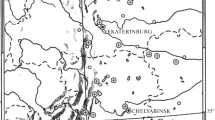Conclusion
In oligohaline watersGammarus tigrinus has a much greater reproductive capacity than any of the three indigenous (sub)speciesG. d. duebeni, G. zaddachi orG. p. pulex. The most important factors that enable this recently introduced species to compete the local species are: (a) its favourable reproductive period during the warm summer months, (b) its very short egg-incubation period, and (c) its very short time needed to reach sexual maturity.
So if (1)G. tigrinus tends to occupy the same habitats as the originalGammarus species and (2) it is subjected to the same density controlling factors then its greater reproductive capacity will enable this species to outnumber and gradually replace the three indigenous species.
Similar content being viewed by others
References
CHAMBERS, M.R., 1971. Studies on the littoral fauna of Tjeukemeer. Ph. D. thesis Univ. of Liverpool: 1–281.
DENNERT, H.G., A.L. DENNERT, P. KANT, S. PINKSTER and J.H. STOCK, 1969. Upstream and downstream migrations in relation to the reproductive cycle and to environmental factors of the amphipodGammarus zaddachi. Bijdr. Dierk., 39(1): 11–43.
DENNERT, H.G. and M.J. VAN MAREN, 1974. Further observations on the migration ofGammarus zaddachi Sexton (Crustacea, Amphipoda) in a french stream. Bull. zool. Mus. Univ. Amsterdam, 3 (20): 157–167.
DORGELO, J., 1974. Comparative ecophysiology of gammarids (Crustacea: Amphipoda) from marine, brackish and fresh-water habitats, exposed to the influence of salinity-temperature combinations. I. Effect on survival. Hydrobiol. Bull., 8 (1–2): 90–108.
DORGELO, J., 1976. Comparative ecophysiology of gammarids (Crustacea: Amphipoda) from marine, brackish and fresh-water habitats, exposed to the influence of salinity-temperature combinations. II. Preference experiments. Verh. int. Verein. theor. angew. Limnol., 19 (in press).
HARTOG, C. DEN and A.S. TULP, 1960. Hydrobiologische waarnemingen in Friesland (slot). Levende Natuur, 63 (6): 133–140.
HARTOG, C. DEN 1964. The amphipods of the Deltaic region of the rivers Rhine, Meuse and Scheldt in relation to the hydrography of the area. Part III Gammaridae. Neth. J. Sea Res., 2 (3): 407–457.
HEINZE, K., 1932. Fortpflanzung und Brutpflege beiGammarus pulex L. undCarinogammarus roeselii Gerv. Inaugural-Dissertation, Berlin: 398–440.
HYNES, H.B.N., 1954. The ecology ofGammarus duebeni Lilljeborg and its occurrence in fresh water in western Britain. J. anim. Ecol., 23: 38–84.
HYNES, H.B.N., 1955. The reproductive cycle of some British fresh-water gammaridae. J. anim. Ecol., 24: 352–387.
KINNE, O., 1953. Zur Biologie und Physiologie vonGammarus duebeni Lillj., 1. Zeitschr. wiss. Zool., 157: 427–491.
KINNE, O., 1959. Ecological data on the AmphipodGammarus duebeni, a monograph. Veröff. Inst. Meeresforsch. Bremerhaven, 6: 177–186.
KINNE, O., 1961. Growth, molting frequency, heart beat, number of eggs, and incubation time inGammarus zaddachi exposed to different environments. Crustaceana, 2 (1): 26–34.
NIJSSEN, H. and J.H. STOCK, 1966. The amphipodGammarus tigrinus Sexton, 1939, introduced in the Netherlands (Crustacea). Beaufortia, 13 (60): 197–206.
ROUX, A.L., 1970. Le cycle de reproduction de deux espèces étroitement parentes de Crustacés Amphipodes:Gammarux pulex etG. fossarum. Ann. Limnol., 6 (1): 27–49.
RUOFF, K., 1968. Experimentelle Untersuchungen über den in die Weser eingebürgerten amerikanischen BachflohkrebseGammarus tigrinus Sexton. Arch. Fischwiss., 19 (2–3): 134–158.
SMIT, H., 1974. Extension de l'aire de répartition deGammarus tigrinus Sexton en 1973 aux Pays Bas, et quelques remarques sur la concurrence avec les gammares indigènes (Crustacea, Amphipoda) Bull. zool. Mus. Univ. Amsterdam, 4 (5): 35–44.
VOS, A.P.C. DE, 1941. Zoologische resultaten van een tocht rond het IJsselmeer van 5–8 juli 1937. Meded. Zuiderzee-Comm. ned. dierk. Vereen., 5: 37–50.
VOS, A.P.C. DE, 1954-a. De littorale fauna van het IJsselmeer. Flora Fauna Zuiderzee, 3: 268–276.
VOS, A.P.C. DE, 1954-b. Over de oever- en bodemfauna der binnendijkse kolken langs het IJsselmeer. Flora Fauna IJsselmeer, 3: 277–282.
Author information
Authors and Affiliations
Rights and permissions
About this article
Cite this article
Pinkster, S. The introduction of the alien amphipodGammarus tigrinus Sexton, 1939 (Crustacea, Amphipoda) in The Netherlands and its competition with indigenous species. Hydrobiological Bulletin 9, 131–138 (1975). https://doi.org/10.1007/BF02263332
Issue Date:
DOI: https://doi.org/10.1007/BF02263332




